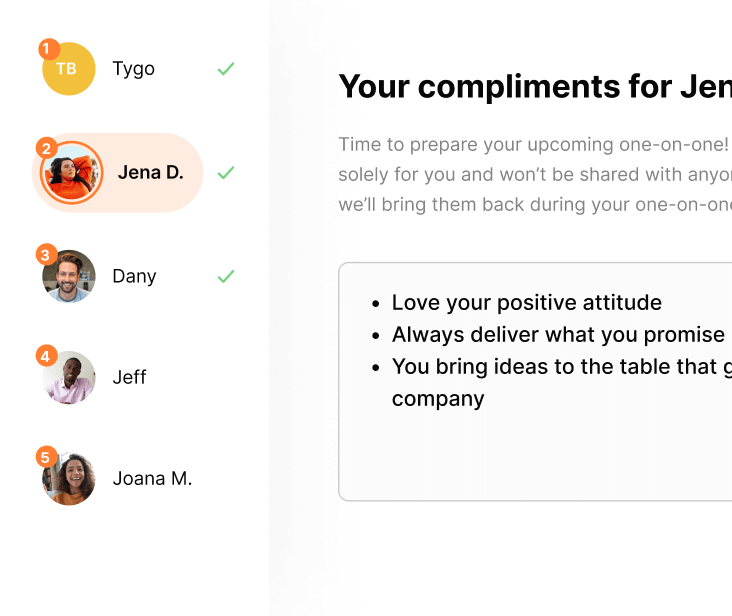Back to Blog
The shocking truth about employee turnover rates (by industry)
Ever wondered whether your employee retention rate is to be expected in your industry? Or whether the recurring loss of team members is down to holes in employee engagement? These are important questions! Keep reading to get a breakdown on typical employee turnover rates in each industry so you can work out whether you need to take action.
What does the turnover rate measure?
Your annual turnover rate measures the number of separations (employees ending their working relationship with your organization) per year.

To calculate your annual turnover rate, take the number of separations during the year and divide that by the average headcount that same year. If your company started the year with 300 employees, ended the year with 350, and 15 people terminated their contract during that year, your turnover rate is 15 / ((300+350)/2) = 0.046 or 4.6%.
Employee turnover rates by industry
If you’ve been searching for historical data and asking ‘what is the average employee turnover rate in 2019’ or ‘what is the average employee turnover in 2021’ (we see you frantically searching for clues) - then you’re in the right place.
Take a look at the latest data from the US Bureau of Labor Statistics for how things have looked over the last few years.
High employee turnover rates (by industry)
Leisure and hospitality - This industry has the highest employee turnover, with 2020 seeing a shocking 130%. While the pandemic may largely be to blame that year, 79% in 2019 is still a huge figure. Likely down to poor rates of pay, long hours, and the challenges of customer service often faced by those in the leisure and hospitality industry.
Professional and business services - This covers a huge variety of businesses with the likelihood of high turnovers due to disengaged employees moving on and company layoffs.
Low employee turnover rates (by industry)
Government - Govermnent roles have the lowest employee turnover rates, with an impressively low turnover rate of 19% pre-pandemic. This can be put down to policies that typically make it hard to lay off employees, as well as a more urgent need to keep employees engaged and well compensated (for workplace security and stability). Having said that, there were a ton of Government layoffs in 2020 - hence the spike!
Financial - Another industry which is known for its generous financial rewards, this is likely to be a key factor in having such low turnover rates.
Share fun facts and bond with a team quiz
Have your participants choose from a list of questions they’d like their coworkers to answer about them, before watching as they guess the right answer.
01. Yes
share-fun-facts-and-bond-with-a-team-quiz

Run a guided recognition activity
Have your participants choose from a list of questions they’d like their coworkers to answer about them, before watching as they guess the right answer.
01. Yes
run-a-guided-recognition-activity

Organize a virtual cooking class
Hire a professional chef to help your team cook a delicious lunch or dinner. May be difficult for co-workers with families. To find providers and get tips, read our blog about virtual cooking classes.
02. No
organize-a-virtual-cooking-class

Hire a stand-up comedian
Have your participants choose from a list of questions they’d like their coworkers to answer about them, before watching as they guess the right answer.
02. No
hire-a-stand-up-comedian

No items found
No items found
Table of contents
Ever wondered whether your employee retention rate is to be expected in your industry? Or whether the recurring loss of team members is down to holes in employee engagement? These are important questions! Keep reading to get a breakdown on typical employee turnover rates in each industry so you can work out whether you need to take action.
What does the turnover rate measure?
Your annual turnover rate measures the number of separations (employees ending their working relationship with your organization) per year.

To calculate your annual turnover rate, take the number of separations during the year and divide that by the average headcount that same year. If your company started the year with 300 employees, ended the year with 350, and 15 people terminated their contract during that year, your turnover rate is 15 / ((300+350)/2) = 0.046 or 4.6%.
Employee turnover rates by industry
If you’ve been searching for historical data and asking ‘what is the average employee turnover rate in 2019’ or ‘what is the average employee turnover in 2021’ (we see you frantically searching for clues) - then you’re in the right place.
Take a look at the latest data from the US Bureau of Labor Statistics for how things have looked over the last few years.
High employee turnover rates (by industry)
Leisure and hospitality - This industry has the highest employee turnover, with 2020 seeing a shocking 130%. While the pandemic may largely be to blame that year, 79% in 2019 is still a huge figure. Likely down to poor rates of pay, long hours, and the challenges of customer service often faced by those in the leisure and hospitality industry.
Professional and business services - This covers a huge variety of businesses with the likelihood of high turnovers due to disengaged employees moving on and company layoffs.
Low employee turnover rates (by industry)
Government - Govermnent roles have the lowest employee turnover rates, with an impressively low turnover rate of 19% pre-pandemic. This can be put down to policies that typically make it hard to lay off employees, as well as a more urgent need to keep employees engaged and well compensated (for workplace security and stability). Having said that, there were a ton of Government layoffs in 2020 - hence the spike!
Financial - Another industry which is known for its generous financial rewards, this is likely to be a key factor in having such low turnover rates.
Historical trends: Employee turnover from 2019-2022
Employee turnover rate has been a hot topic for the last few years, thanks to the ‘Great Resignation’ - an elevated rate at which workers are willing to leave their current employers.
As we can see from the data below, it’s the 2020 pandemic that kicks the rates up. This is likely due to a multitude of reasons - illness, the desire to work more flexibly around family, they want to work remotely, and even the wish to change careers following life reflections during lockdowns.
While 2021 rates declined again, they’re still up from 2019, suggesting employees were still more willing to leave employment if they felt unsatisfied and that employees were not holding back on layoffs when needed.
At the time of writing this, the data for 2022 is yet to be confirmed. Earlier in the year, it was predicted that employee turnover would jump by as much as 20% from the pre-pandemic average. It will be interesting to see if this is the case!
How do well-known organizations do? Let’s look at employee turnover rates by company
If you’re wondering how the big players do, well, you might be shocked! Here are some recent turnover stats and why they’re likely.
- Google - While we haven’t found an exact figure for the turnover rate, it’s known that Google’s average employee tenure is just over a year - meaning the turnover rate must be high. With a 4.5 out of 5 glassdoor rating, this is less likely about lack of employee engagement and more about the opportunities for growth that Google provides, springboarding employees elsewhere.
- Amazon - With an astronomical employee turnover rate (up to 64.6% in some departments) and a 3.8 out of 5 glassdoor rating, it’s clear Amazon has some employee engagement issues. Hiring practices, productivity quotas, attendance policies, and unequal enforcement of rules are just some of the negatives employees have pinpointed.
- Apple - Apple has been consistently ranked in Glassdoor’s Top 100 Companies to Work for and recently raised its retention rate (the number of employees staying onboard) from 61% to an impressive 89%. Feedback has pinpointed Apple’s low employee turnover rate to ‘connection’: they feel like one Apple - with a strong sense of company culture, pride, and values.
Wanting to understand more about employee engagement and the drivers of employee retention? Take a look at our other articles:
- Our quick-fire guide to employee engagement measurement
- 2022 employee engagement statistics: trends, stats + charts
- 9 main drivers to keep employee retention high
Keen to learn how to manage and increase employee engagement for your teams? These will also help:
Subscribe to get our latest updates
Subscribe to get our latest updates
%20(1)-p-500.webp)



.jpg)
.jpg)
